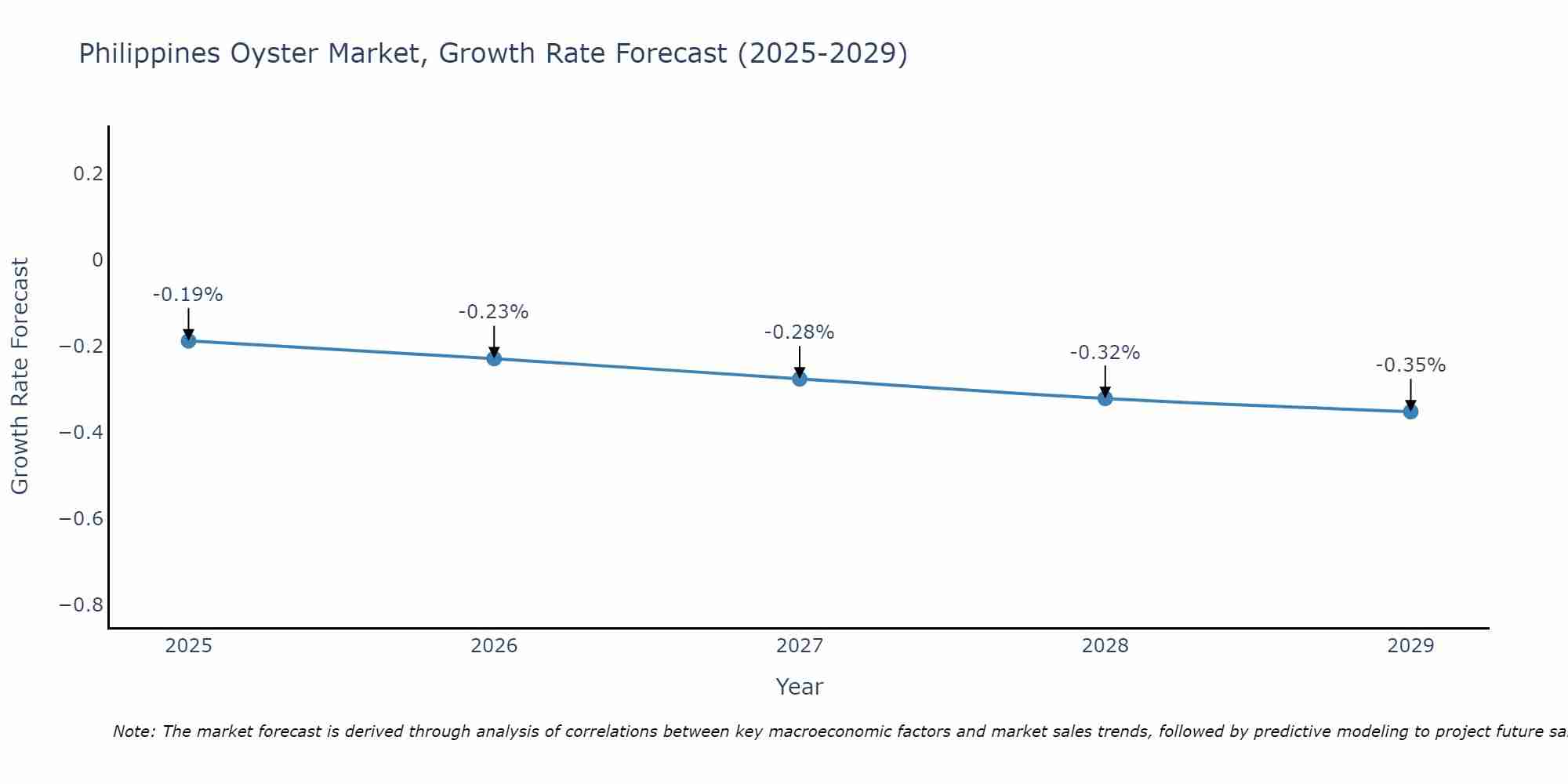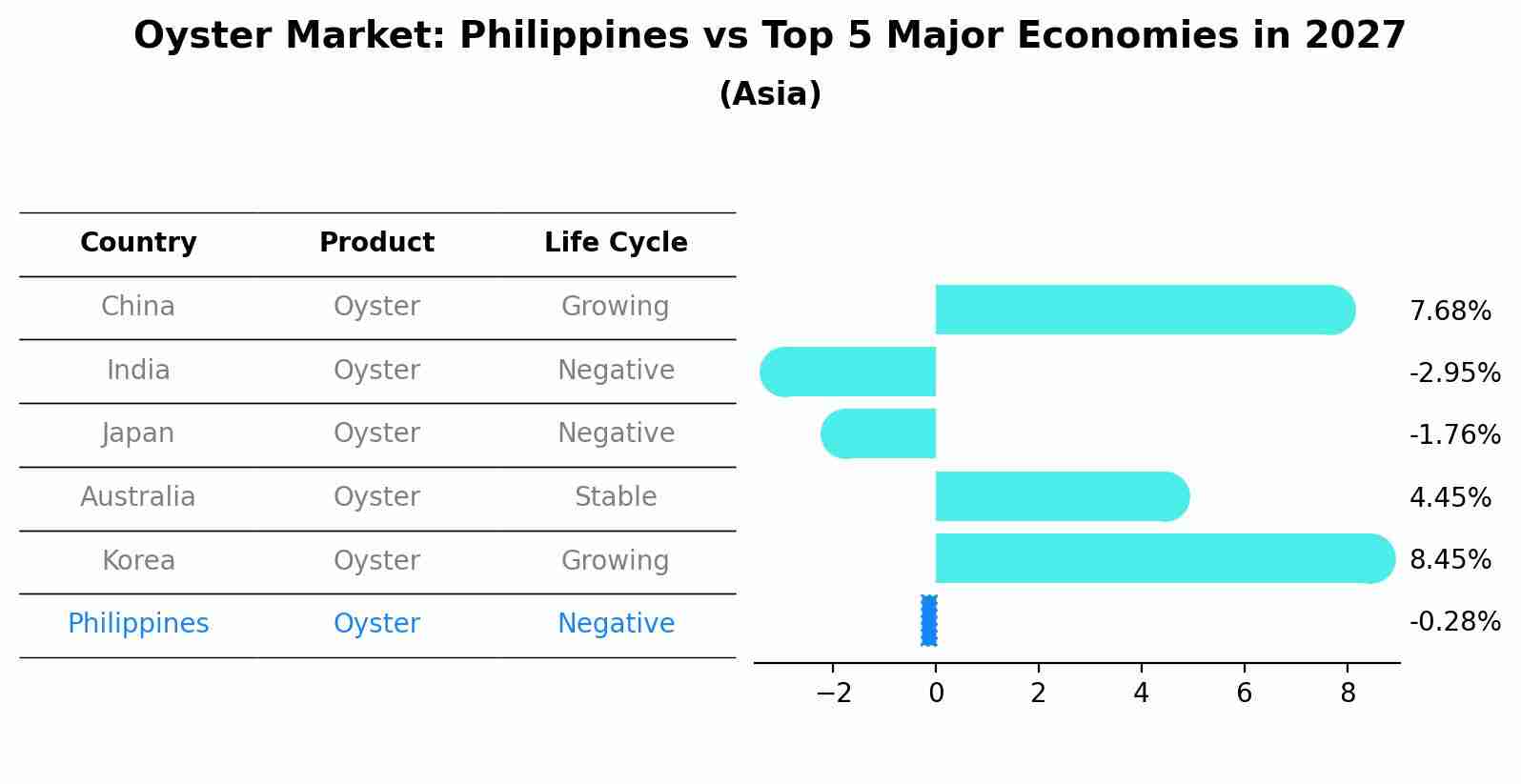Philippines Oyster Market (2025-2031) Outlook | Share, Forecast, Trends, Analysis, Growth, Industry, Companies, Revenue, Size & Value
| Product Code: ETC387509 | Publication Date: Aug 2022 | Updated Date: Apr 2025 | Product Type: Market Research Report | |
| Publisher: 6Wresearch | Author: Ravi Bhandari | No. of Pages: 75 | No. of Figures: 35 | No. of Tables: 20 |
Philippines Oyster Market Size Growth Rate
The Philippines Oyster Market may undergo a gradual slowdown in growth rates between 2025 and 2029. Starting high at -0.19% in 2025, the market steadily declines to -0.35% by 2029.

Oyster Market: Philippines vs Top 5 Major Economies in 2027 (Asia)
By 2027, Philippines's Oyster market is forecasted to achieve a negative growth rate of -0.28%, with China leading the Asia region, followed by India, Japan, Australia and South Korea.

philippines oyster market Synopsis
The oyster market in the Philippines has witnessed steady growth in recent years due to increasing consumer demand for seafood products. Oysters are highly valued for their unique taste and nutritional benefits. The Philippines` coastal geography provides suitable conditions for oyster cultivation, contributing to a consistent supply. Local oyster farms and aquaculture operations play a significant role in meeting both domestic and potential international market demands. As awareness about the health benefits of oysters grows, the market is expected to continue its upward trajectory.
Drivers of the Market
The Philippines oyster market is influenced by factors such as the country`s coastal geography, consumer preferences for seafood, and the reputation of oysters as a delicacy. Oysters are commonly consumed raw or cooked and are often associated with special occasions and fine dining. The growth of tourism and the presence of coastal restaurants and seafood markets also play a role in driving the demand for oysters.
Challenges of the Market
The Philippines oyster market faces challenges related to environmental factors and food safety. Coastal pollution and habitat degradation can affect oyster quality and safety, leading to concerns about contaminants and bacterial contamination. Additionally, changing oceanic conditions, including water temperature and acidity, can impact oyster growth and survival. Balancing sustainable harvesting practices with the demand for oysters and ensuring consistent product quality are ongoing challenges in this market.
COVID-19 Impact on the Market
The Philippines oyster market encountered challenges due to the pandemic. Reduced tourism and closure of restaurants impacted sales. Supply chain disruptions affected availability, and labor shortages affected oyster harvesting and distribution. Recovery required reopening tourism, revitalizing the hospitality industry, and rebuilding supply chains. Consumer trust and adherence to safety measures were crucial for market rebound.
Key Players in the Market
Oyster retail and distribution in the Philippines involve a mix of local seafood markets, restaurants, and seafood suppliers. Some well-known seafood suppliers and distributors include The Red Crab Group, Seascape Village, and various seafood wholesalers in markets like Dampa Seaside Macapagal.
Key Highlights of the Report:
- Philippines Oyster Market Outlook
- Market Size of Philippines Oyster Market, 2024
- Forecast of Philippines Oyster Market, 2031
- Historical Data and Forecast of Philippines Oyster Revenues & Volume for the Period 2021-2031
- Philippines Oyster Market Trend Evolution
- Philippines Oyster Market Drivers and Challenges
- Philippines Oyster Price Trends
- Philippines Oyster Porter's Five Forces
- Philippines Oyster Industry Life Cycle
- Historical Data and Forecast of Philippines Oyster Market Revenues & Volume By Oyster Type for the Period 2021-2031
- Historical Data and Forecast of Philippines Oyster Market Revenues & Volume By Cupped Oyster for the Period 2021-2031
- Historical Data and Forecast of Philippines Oyster Market Revenues & Volume By Pacific Cupped Oyster for the Period 2021-2031
- Historical Data and Forecast of Philippines Oyster Market Revenues & Volume By American Cupped Oyster for the Period 2021-2031
- Historical Data and Forecast of Philippines Oyster Market Revenues & Volume By Penguin Wing Oyster for the Period 2021-2031
- Historical Data and Forecast of Philippines Oyster Market Revenues & Volume By Others for the Period 2021-2031
- Historical Data and Forecast of Philippines Oyster Market Revenues & Volume By End User for the Period 2021-2031
- Historical Data and Forecast of Philippines Oyster Market Revenues & Volume By Foodservice for the Period 2021-2031
- Historical Data and Forecast of Philippines Oyster Market Revenues & Volume By Retail for the Period 2021-2031
- Historical Data and Forecast of Philippines Oyster Market Revenues & Volume By Packaging Form for the Period 2021-2031
- Historical Data and Forecast of Philippines Oyster Market Revenues & Volume By Fresh for the Period 2021-2031
- Historical Data and Forecast of Philippines Oyster Market Revenues & Volume By Frozen for the Period 2021-2031
- Historical Data and Forecast of Philippines Oyster Market Revenues & Volume By Canned for the Period 2021-2031
- Historical Data and Forecast of Philippines Oyster Market Revenues & Volume By Others for the Period 2021-2031
- Philippines Oyster Import Export Trade Statistics
- Market Opportunity Assessment By Oyster Type
- Market Opportunity Assessment By End User
- Market Opportunity Assessment By Packaging Form
- Philippines Oyster Top Companies Market Share
- Philippines Oyster Competitive Benchmarking By Technical and Operational Parameters
- Philippines Oyster Company Profiles
- Philippines Oyster Key Strategic Recommendations
Frequently Asked Questions About the Market Study (FAQs):
- Single User License$ 1,995
- Department License$ 2,400
- Site License$ 3,120
- Global License$ 3,795
Search
Thought Leadership and Analyst Meet
Our Clients
Related Reports
- Afghanistan Apparel Market (2026-2032) | Growth, Outlook, Industry, Segmentation, Forecast, Size, Companies, Trends, Value, Share, Analysis & Revenue
- Canada Oil and Gas Market (2026-2032) | Share, Segmentation, Value, Industry, Trends, Forecast, Analysis, Size & Revenue, Growth, Competitive Landscape, Outlook, Companies
- Germany Breakfast Food Market (2026-2032) | Industry, Share, Growth, Size, Companies, Value, Analysis, Revenue, Trends, Forecast & Outlook
- Australia Briquette Market (2025-2031) | Growth, Size, Revenue, Forecast, Analysis, Trends, Value, Share, Industry & Companies
- Vietnam System Integrator Market (2025-2031) | Size, Companies, Analysis, Industry, Value, Forecast, Growth, Trends, Revenue & Share
- ASEAN and Thailand Brain Health Supplements Market (2025-2031) | Strategy, Consumer Insights, Analysis, Investment Trends, Opportunities, Growth, Size, Share, Industry, Revenue, Segments, Value, Segmentation, Supply, Forecast, Restraints, Outlook, Competition, Drivers, Trends, Demand, Pricing Analysis, Competitive, Strategic Insights, Companies, Challenges
- ASEAN Bearings Market (2025-2031) | Strategy, Consumer Insights, Analysis, Investment Trends, Opportunities, Growth, Size, Share, Industry, Revenue, Segments, Value, Segmentation, Supply, Forecast, Restraints, Outlook, Competition, Drivers, Trends, Demand, Pricing Analysis, Competitive, Strategic Insights, Companies, Challenges
- Europe Flooring Market (2025-2031) | Outlook, Share, Industry, Trends, Forecast, Companies, Revenue, Size, Analysis, Growth & Value
- Saudi Arabia Manlift Market (2025-2031) | Outlook, Size, Growth, Trends, Companies, Industry, Revenue, Value, Share, Forecast & Analysis
- Uganda Excavator, Crane, and Wheel Loaders Market (2025-2031) | Strategy, Consumer Insights, Analysis, Investment Trends, Opportunities, Growth, Size, Share, Industry, Revenue, Segments, Value, Segmentation, Supply, Forecast, Restraints, Outlook, Competition, Drivers, Trends, Demand, Pricing Analysis, Competitive, Strategic Insights, Companies, Challenges
Industry Events and Analyst Meet
Whitepaper
- Middle East & Africa Commercial Security Market Click here to view more.
- Middle East & Africa Fire Safety Systems & Equipment Market Click here to view more.
- GCC Drone Market Click here to view more.
- Middle East Lighting Fixture Market Click here to view more.
- GCC Physical & Perimeter Security Market Click here to view more.
6WResearch In News
- Doha a strategic location for EV manufacturing hub: IPA Qatar
- Demand for luxury TVs surging in the GCC, says Samsung
- Empowering Growth: The Thriving Journey of Bangladesh’s Cable Industry
- Demand for luxury TVs surging in the GCC, says Samsung
- Video call with a traditional healer? Once unthinkable, it’s now common in South Africa
- Intelligent Buildings To Smooth GCC’s Path To Net Zero


















